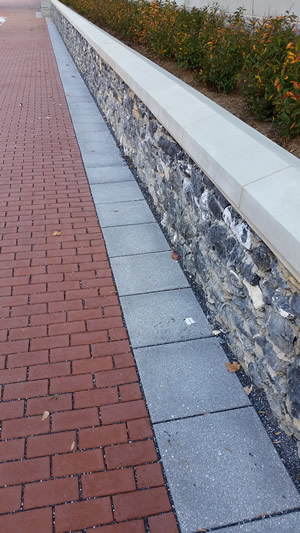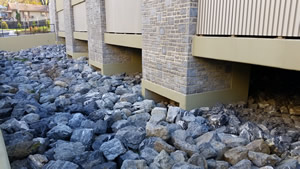An Integrated Approach to Stormwater Management
Addressing stormwater controls early in facilities design and incorporating multiple solutions can yield cost savings and long-term benefits to a campus and its neighbors.
- By Carolyn Howard
- 03/11/19
Colleges and universities face a myriad of challenges when managing their facilities and campuses, not the least of which can be related to topography or site selection. Many schools are landlocked by surrounding developments, which can result in the need to get creative when it comes to designing and building new facilities. Given the complexities of delivering new facilities, especially on challenging sites, the role of stormwater controls can get overlooked in the planning process.
 Yet, thoughtful planning for stormwater management early in the design process for new facilities can alleviate common pitfalls and headaches. Furthermore, leveraging an approach to stormwater controls that integrates multiple best practices can yield improved results and a better end-product. Higher education administrators and their design/build teams would be wise to consider early in the design process a holistic approach to stormwater management, because this integrated approach can better service the needs of the institution and offer a variety of advantages.
Yet, thoughtful planning for stormwater management early in the design process for new facilities can alleviate common pitfalls and headaches. Furthermore, leveraging an approach to stormwater controls that integrates multiple best practices can yield improved results and a better end-product. Higher education administrators and their design/build teams would be wise to consider early in the design process a holistic approach to stormwater management, because this integrated approach can better service the needs of the institution and offer a variety of advantages.
First, this integrated approach encourages the team to incorporate stormwater planning early in the design/build process for a new campus facility. All projects require stormwater solutions that must be tailored to a specific project’s location, use, and goals. Increasingly, those needs call for multiple stormwater controls. As the number of controls increases so does the time needed to design them, which compels the team to consider stormwater planning early and identify how stormwater controls will be utilized, providing multiple benefits to the project. This strategy will save time, money, and heartache later!
A Challenge Met and Solved
Virginia Military Institute (VMI) recently faced a stormwater design challenge when planning the school’s new Corps Physical Training Facility, a state-of-the-art training facility that houses track-and-field activities, full locker rooms, classrooms, coaches and administrative offices, athletic training facilities, and more. Nestled among the Blue Ridge Mountains in Lexington, VA, VMI is the oldest state-supported military college in the U.S.
Topographic and geologic constraints at VMI create a unique and daunting set of challenges anytime the school needs to add new facilities. VMI is located in an area with steep slopes and karst geology (a.k.a. sinkholes). An initial site limitation to the training facility was the Town Branch creek, which runs beneath the building and is prone to flooding. Addressing this issue became a key factor in the new facility’s success. An array of stormwater controls were used to accomplish a number of objectives, including no impact to the current flood zone adjacent to the creek at VMI and in the surrounding community. Of course, stormwater planning also had to take into account erosion control phasing during construction to prevent sediment from washing into the creek from the job site in order to minimize environmental impacts to the stream.
 Stormwater controls were planned early in the design process and tailored to the site’s conditions, geology, and ultimate use. In all, this project called for more than a dozen stormwater controls, including a vegetative roof, three bioretention ponds, permeable pavers, an underground cistern to collect runoff, an underground stormwater retention facility, and five manufactured BMPs.
Stormwater controls were planned early in the design process and tailored to the site’s conditions, geology, and ultimate use. In all, this project called for more than a dozen stormwater controls, including a vegetative roof, three bioretention ponds, permeable pavers, an underground cistern to collect runoff, an underground stormwater retention facility, and five manufactured BMPs.
By planning ahead, school officials and the design/build team could better understand project constraints and opportunities, manage project schedules, and craft an accurate construction budget.
The Value of Collaboration
A second advantage to taking an integrated approach to stormwater controls is that it generates greater collaboration. Working with multiple stormwater controls and BMPs requires significant understanding of each control and how it will interact with the building and site features. Collaboration by the entire design/build team is needed to identify possible challenges and opportunities for these stormwater solutions. By taking an integrated approach with multiple stormwater solutions, the entire team is likely to collaborate more consistently.
Returning to the VMI facility, collaboration was crucial to the project’s delivery. For example, one such collaborative effort resulted in the elevation of the facility above creek level to prevent future flood damage. Flood models, developed with input from the design/build team, helped guide that elevation. As a result of this teamwork, the design team recognized the need to utilize as much space as possible to mitigate flooding events and incorporated the parking structure under the building. Thus, if flooding occurs from a storm event greater than the 100-year storm event, the parking structure serves as an overflow route for that stormwater, thereby not impacting to the primary building space.
A key lesson for colleges and universities is to encourage collaboration throughout the entire process through the installation of all stormwater controls. This ongoing communication will return dividends by delivering more innovative stormwater controls and avoiding added expenses related to incorrectly installed or insufficient controls.
Handling Permits and Regulations
A third benefit is leveraging the stormwater controls to assist with permit approval. An ever-changing regulatory environment can complicate the permit approval process. However, the approval process can run more smoothly if stormwater issues are addressed up front. With permit requirements becoming stricter, it’s crucial to consider the purpose of all stormwater controls and how they will be managed during initial concept planning.
Whether a public or private project, think beyond the project’s immediate boundaries to options on other lands. The result often provides more watershed benefits and volume controls than at the project site. For example, if your project is in a remote area, consider installing the required control, such as a bioretention basin, on other land you might control within the same watershed, such as next to a parking lot. This will provide more benefit through greater pollutant removal and volume reduction by addressing the parking lot rather than an undeveloped area. This creative approach can help secure the necessary permits for a project to move forward.
Finally, an integrated approach to multiple stormwater controls allows for more creative thinking, especially when addressing site constraints and cost savings, two key factors for most colleges and universities.
For example, construction of traditional bioretention at VMI was challenging because of the steep slopes on the site. Brainstorming outside-of-the-box ideas was critical in order to create a “stepped” bioretention basin design, where water flows into two to four terraces before overflowing through the lower basins and ultimately running into the stream after it had been filtered.
Creative solutions can deliver cost savings as well. Consider creating a rainwater harvesting control where water is collected for use within the building. While the control helps filter water runoff, it also saves on utility bills by recycling the rainwater into the building’s cooling and grey-water system. Another example of creative stormwater controls that save money is when they’re used for multiple purposes. Use permeable pavers in sidewalk and vehicular areas to provide an aesthetically-pleasing surface, while providing treatment of stormwater runoff.
Higher education institutions are bastions of creativity and are ideal locations to leverage an integrated approach to stormwater controls. Addressing these controls early and incorporating multiple stormwater solutions can yield cost savings and long-term benefits to the campus and its neighbors. Sounds like a good strategy to ace a new project’s delivery.